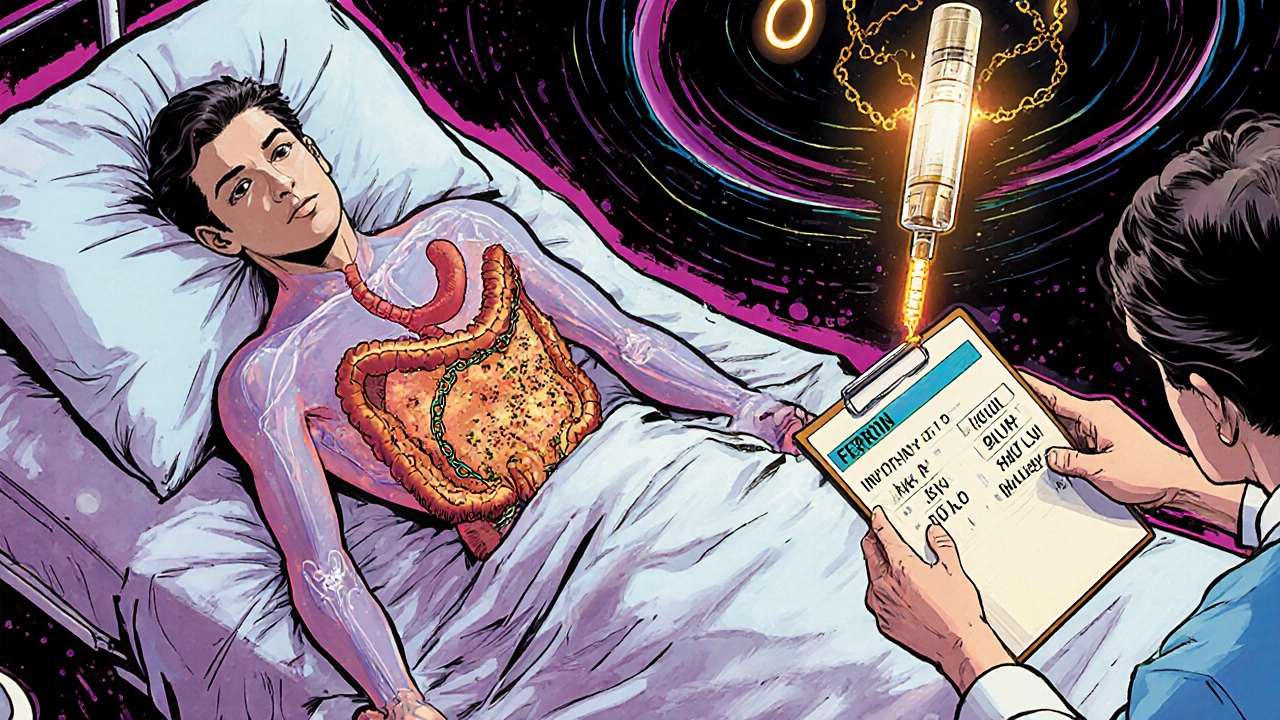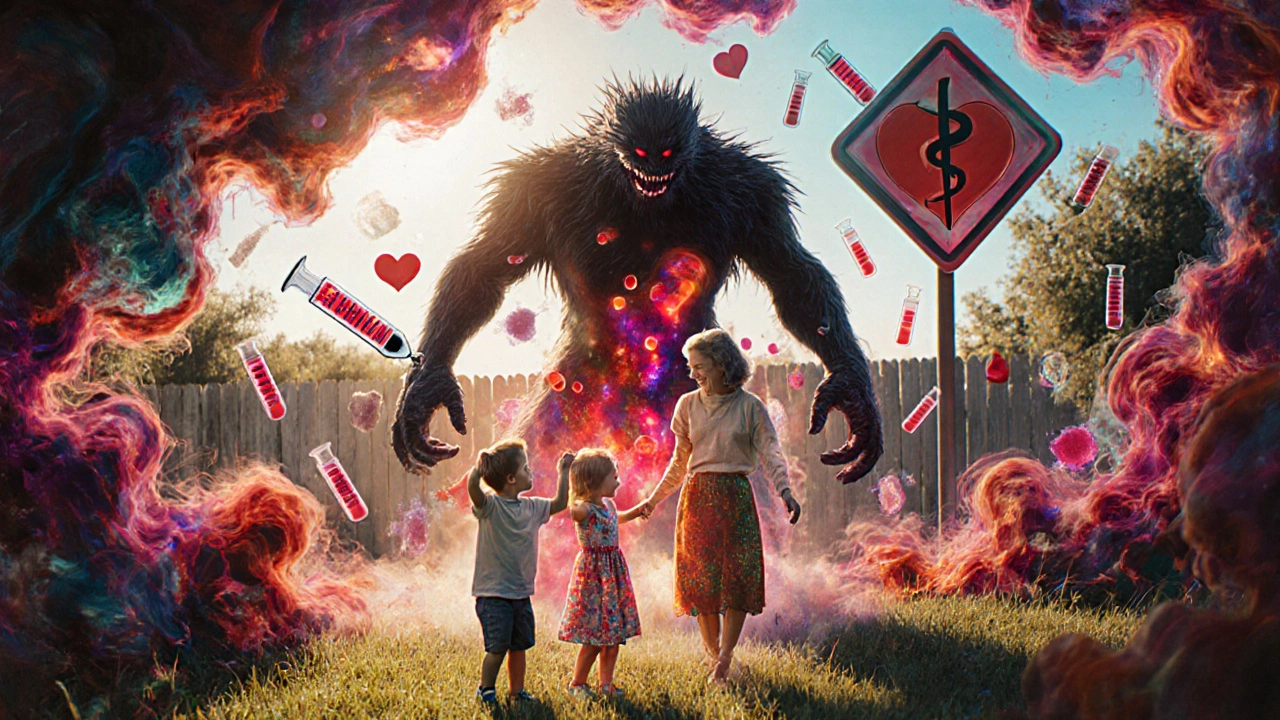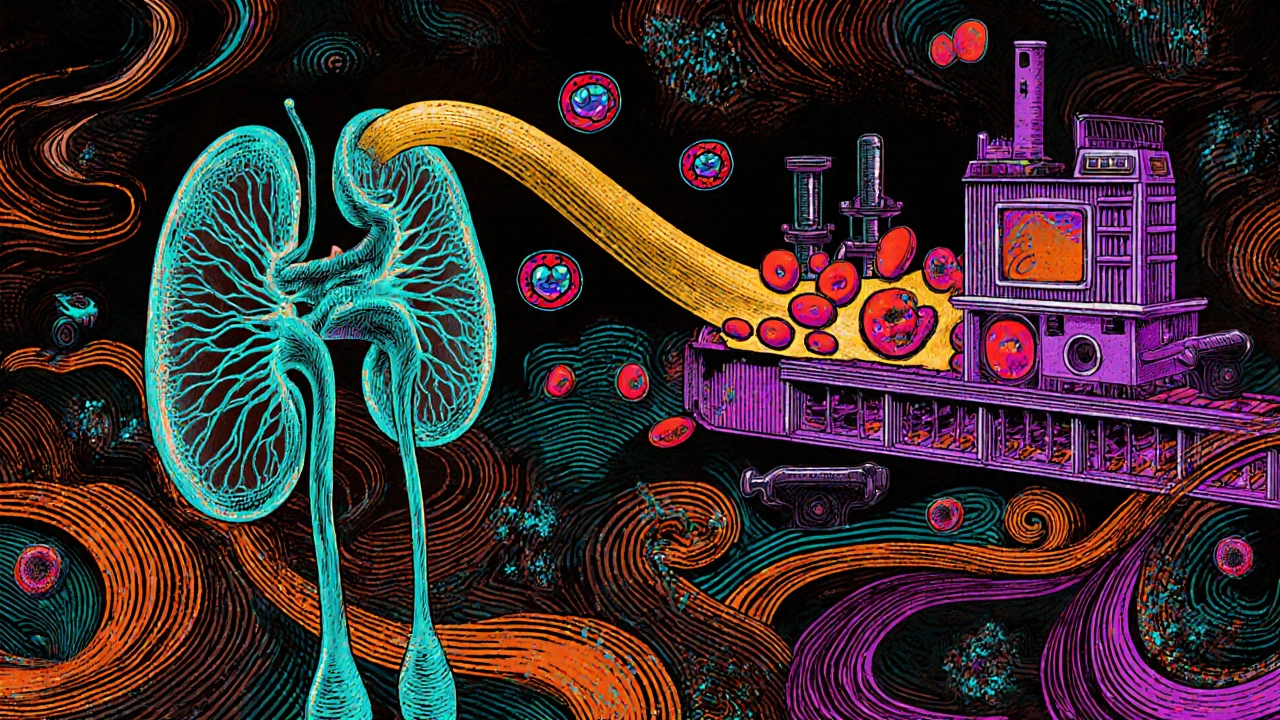Why anemia hits hard when your kidneys are failing
When your kidneys aren’t working right, they stop making enough erythropoietin - a hormone that tells your bone marrow to produce red blood cells. Without it, your body can’t carry enough oxygen, and you start feeling tired, short of breath, and dizzy. This isn’t just regular anemia. It’s anemia tied directly to chronic kidney disease (CKD), and it affects more than half of all people with moderate to severe kidney damage. Unlike iron-deficiency anemia from diet or blood loss, this type is caused by a broken signal between your kidneys and your blood. And fixing it isn’t as simple as taking a vitamin.
The two keys: Erythropoietin and iron - but not just any iron
There are two main tools doctors use to treat anemia in kidney disease: erythropoiesis-stimulating agents (ESAs) and iron therapy. ESAs are lab-made versions of erythropoietin. They come as injections - either under the skin or into a vein - and they kick-start red blood cell production. Common ones include epoetin alfa, darbepoetin alfa, and newer biosimilars like Retacrit. But here’s the catch: these drugs won’t work if you’re low on iron. Your body needs iron to build those new red blood cells. Think of ESAs as the factory foreman and iron as the raw material. No material? No production.
Iron therapy isn’t one-size-fits-all. Oral iron pills - the kind you buy at the drugstore - barely help in CKD. Why? Because inflammation from kidney disease locks iron inside your storage cells. Your body sees the iron, but can’t use it. That’s called functional iron deficiency. Studies show oral iron gets absorbed at only 30-40% in CKD patients. IV iron, on the other hand, bypasses the gut entirely. It goes straight into your bloodstream. For hemodialysis patients, monthly IV iron sucrose doses of 400 mg are common. It works faster, better, and with fewer stomach issues than pills.
How do you know if you need iron or ESA therapy?
Doctors don’t guess. They test. Two numbers matter most: ferritin and transferrin saturation (TSAT). Ferritin tells you how much stored iron you have. TSAT shows how much iron is actually floating around ready to be used. The 2025 KDIGO guidelines say:
- If your ferritin is below 100 mcg/L, you have absolute iron deficiency - start IV iron right away.
- If your ferritin is between 100 and 500 mcg/L but your TSAT is under 20-30%, you have functional iron deficiency - still need IV iron.
- If your hemoglobin is below 10 g/dL after iron correction, then add an ESA.
Some patients get confused when their ferritin is 300 or 400 and their doctor still gives them IV iron. That’s not a mistake. It’s science. The old idea that ferritin above 500 is safe doesn’t hold up anymore. KDIGO now says even ferritin up to 500 ng/mL with low TSAT needs treatment. The goal isn’t just to raise numbers - it’s to make you feel better without risking your heart.
Target hemoglobin: Not too high, not too low
For years, doctors tried to push hemoglobin levels up to 12 or even 13 g/dL, thinking more red cells meant more energy. But big studies like the TREAT trial in 2009 showed that pushing hemoglobin above 11.5 g/dL increased the risk of stroke, heart attack, and blood clots. Today, the goal is 10 to 11.5 g/dL. That’s enough to reduce fatigue and avoid transfusions - without putting extra strain on your heart.
One patient in a Mayo Clinic case report went from 8.2 to 10.5 g/dL in eight weeks with darbepoetin and weekly IV iron. He said he could finally play with his grandkids without gasping for air. That’s the win. But another patient, kept at 12.5 g/dL because of outdated protocols, ended up in the hospital with a blood clot. That’s the risk.

What about new oral drugs like roxadustat?
There’s a new player in town: HIF-PHIs. Roxadustat, daprodustat, and others work differently. Instead of replacing erythropoietin, they trick your body into making more of it naturally. They’re taken as pills, which is a huge convenience. The FDA approved roxadustat in December 2023 after safety reviews. Early data shows it can raise hemoglobin as well as ESAs, with fewer spikes in blood pressure.
But they’re not perfect. There are still concerns about tumor growth in patients with a history of cancer. That’s why they’re not first-line for everyone. Right now, they’re mostly used when ESAs aren’t working, or when patients can’t tolerate injections. But they’re the future. In the next five years, they could take a big chunk of the $12.8 billion anemia-in-CKD market.
Side effects you need to watch for
Every treatment has downsides. With ESAs, the biggest problem is high blood pressure. About 25-30% of patients see their BP rise after starting treatment. That means more meds, more doctor visits, and more stress on the heart. Some people also get headaches, nausea, or injection site pain.
IV iron isn’t harmless either. About 45% of patients report a metallic taste. Around 28% feel flu-like symptoms for a few hours after the infusion. Rarely - about 1 in 500 - people have serious allergic reactions. That’s why IV iron is given slowly and monitored.
And then there’s iron overload. If ferritin keeps climbing past 800 mcg/L, you risk damage to your liver and heart. That’s why doctors check levels every month. It’s not a set-it-and-forget-it treatment.
Why some treatments fail - and what to do
About 10% of CKD patients don’t respond to ESA therapy. This is called ESA hyporesponsiveness. The most common cause? Unaddressed iron deficiency. Other reasons include inflammation from infection or autoimmune disease, vitamin B12 or folate deficiency, or even aluminum toxicity from old dialysis solutions.
If your hemoglobin doesn’t rise by at least 1 g/dL after 12 weeks of proper ESA and iron dosing, your doctor needs to dig deeper. A full workup might include checking for hidden infections, testing for parathyroid hormone levels, or ruling out bone marrow problems. Sometimes, switching from epoetin to darbepoetin helps. Sometimes, increasing the IV iron dose does the trick.

What the guidelines say - and what hospitals actually do
KDIGO’s 2025 draft is clear: individualize care. Don’t chase a number. Watch how the patient feels. Avoid hemoglobin above 11.5 g/dL. Use IV iron early. But real-world practice lags behind. A 2018 JAMA study found that 22% of U.S. dialysis patients still had hemoglobin above 11 g/dL - even though guidelines had warned against it for years.
Why? Time pressure. Staff shortages. Outdated protocols. Fear of transfusions. It’s not that doctors don’t know better - it’s that changing systems is hard. That’s why patient advocacy matters. If you’re on dialysis and feel tired, ask: “Is my hemoglobin in the 10-11.5 range? Are my iron levels checked monthly? Am I getting IV iron if needed?”
What’s next for anemia treatment in kidney disease
The future is personalization. Mayo Clinic is testing machine learning models that predict exactly how much ESA or iron a patient needs based on their weight, age, dialysis schedule, and past response. Early results show a 22% drop in dosing errors.
Another promising area: minihepcidins. These are experimental drugs that block hepcidin - the protein that locks iron away during inflammation. If they work, they could make oral iron useful again. That would be a game-changer for non-dialysis patients who hate needles.
For now, the standard remains: check iron, give IV iron if needed, start ESA only if hemoglobin stays low, and never push past 11.5 g/dL. The goal isn’t perfection - it’s feeling well enough to live your life.
Can I treat anemia from kidney disease with iron pills alone?
No. Oral iron pills are not effective for most people with chronic kidney disease. Inflammation caused by kidney damage blocks iron absorption in the gut. Studies show only 30-40% of oral iron is absorbed, compared to nearly 100% with IV iron. Even if you take high doses, your hemoglobin won’t rise reliably. IV iron is the standard for dialysis patients and often needed for non-dialysis patients too.
Why do I need to check my iron levels every month?
Because your needs change. As you respond to treatment, your iron gets used up to make new red blood cells. Too little iron makes ESA therapy fail. Too much iron - above 800 mcg/L ferritin - can damage your liver and heart. Monthly tests help your doctor adjust your dose before problems start. It’s not just about numbers - it’s about staying safe while feeling better.
Is it safe to let my hemoglobin stay below 10 g/dL?
Not if you’re symptomatic. A hemoglobin level below 10 g/dL can cause severe fatigue, shortness of breath, and heart strain. But pushing it above 11.5 g/dL increases your risk of stroke and heart attack. The sweet spot is 10-11.5 g/dL. If you’re feeling fine at 9.8 g/dL and your doctor agrees, that’s okay. But if you’re exhausted, dizzy, or can’t walk up stairs, treatment is needed - even if you’re just below 10.
What’s the difference between epoetin and darbepoetin?
Both are erythropoiesis-stimulating agents (ESAs), but darbepoetin lasts longer in your body. Epoetin usually needs to be given 1-3 times a week, while darbepoetin can be given once a week or even every two weeks. That makes it more convenient. Darbepoetin also tends to cause fewer blood pressure spikes. But both work the same way - they tell your bone marrow to make more red blood cells. The choice depends on your schedule, insurance, and how well you respond.
Can I stop ESA therapy once my hemoglobin improves?
Sometimes, but rarely. Most people with advanced kidney disease will need ESA therapy long-term because their kidneys won’t start making erythropoietin again. Stopping therapy usually causes hemoglobin to drop back down within weeks. In rare cases - like after a kidney transplant - doctors may slowly taper off ESAs. But for those on dialysis or with severe CKD, this is typically a lifelong treatment, adjusted as needed.
What you can do right now
If you have kidney disease and feel constantly tired, don’t assume it’s just from aging or your condition. Ask your nephrologist for a full anemia workup: hemoglobin, ferritin, and TSAT. If your numbers are low, push for IV iron - not pills. If you’re on ESA therapy and your energy hasn’t improved in 4-6 weeks, ask if your dose needs adjusting. And always keep your hemoglobin between 10 and 11.5 g/dL. That’s the range that balances quality of life with safety. You deserve to feel strong enough to live - not just survive.

